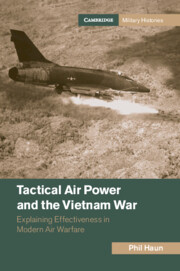Book contents
- Tactical Air Power and the Vietnam War
- Cambridge Military Histories
- Tactical Air Power and the Vietnam War
- Copyright page
- Dedication
- Contents
- Figures
- Maps
- Tables
- Preface
- Abbreviations
- 1 Introduction
- 2 Tactical Air Power Theory
- 3 Vietnam and Rolling Thunder: 1965–1966
- 4 Khe Sanh and Tet: 1967–1968
- 5 Commando Hunt I–III and Cambodia: 1969–1970
- 6 Commando Hunt V–VII and Lam Son 719: 1971–1972
- 7 Easter Offensive and Linebacker I & II: 1972–1973
- 8 Analysis and Conclusion
- 9 Epilogue
- Book part
- Index
3 - Vietnam and Rolling Thunder: 1965–1966
Published online by Cambridge University Press: 04 January 2024
- Tactical Air Power and the Vietnam War
- Cambridge Military Histories
- Tactical Air Power and the Vietnam War
- Copyright page
- Dedication
- Contents
- Figures
- Maps
- Tables
- Preface
- Abbreviations
- 1 Introduction
- 2 Tactical Air Power Theory
- 3 Vietnam and Rolling Thunder: 1965–1966
- 4 Khe Sanh and Tet: 1967–1968
- 5 Commando Hunt I–III and Cambodia: 1969–1970
- 6 Commando Hunt V–VII and Lam Son 719: 1971–1972
- 7 Easter Offensive and Linebacker I & II: 1972–1973
- 8 Analysis and Conclusion
- 9 Epilogue
- Book part
- Index
Summary
Chapter 3 examines the first two years of major US combat operations from 1965 through 1966. Over North Vietnam, the Rolling Thunder air campaign failed to either isolate communist forces in South Vietnam or coerce North Vietnam to withdraw its support of the insurgency. Air power proved more effective in the direct attack of the North Vietnam Army and Viet Cong (NVA/VC) in South Vietnam. The US combined arms campaign thwarted an offensive aimed at dividing South Vietnam. Instead, well-executed allied air-to-ground operations compelled the enemy to disperse and hide.
- Type
- Chapter
- Information
- Tactical Air Power and the Vietnam WarExplaining Effectiveness in Modern Air Warfare, pp. 35 - 76Publisher: Cambridge University PressPrint publication year: 2024

